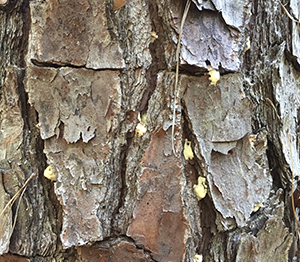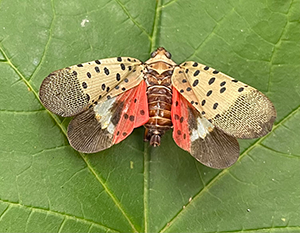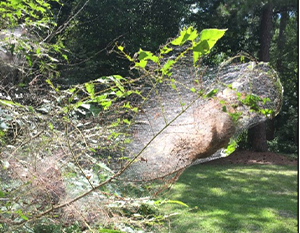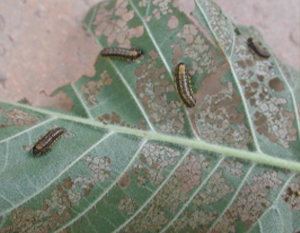Topics in This Newsletter:
- Ornamental Alert (Dr. Ping Yu, UGA Ornamental Specialist)
- Summer tree insects to keep an eye on (Dr. Elizabeth McCarty, UGA Forest Health Specialist)
- Botrytis Blight in Roses (Will Brown, Appling County ANR Agent)
- Upcoming Meeting: Grady County Ornamental update
Ornamental Alert (Dr. Ping Yu, UGA Ornamental Specialist)

This cuphea plant has tiny dots on the back of the leaves, which is caused by the intumescence. The symptoms can be mistaken for edema or eriophyid mites. Here are some tips to differentiate them.
- Intumescence is a physiological disorder where leaves develop bumpy, swollen protrusions which are green, white, or tan. Often happens in GH with high humidity and fluctuating temperatures, low UVB lights.
- Similar to intumescence, edema is also a physiology disorder for plants that can cause similar symptoms. However, edema is most typically observed on the lower leaf surface, while intumescence may be seen on lower or upper surfaces. Symptoms of edema occur on leaf tissue between veins, while intumescence can occur in between or directly on top of the mid-rib and major leaf veins (see the screenshot below).


You can find more information here:
The symptoms of intumescence may also be mistaken for galls formed by eriophyid mites, which cause galls and blisters on plant leaves; however, mites will be absent.
More information on the eriophyid mite can be find here https://extension.usu.edu/planthealth/research/eriophyid-mites.
Summer tree insects to keep an eye on (Dr. Elizabeth McCarty, UGA Forest Health Specialist)
Summer may bring sunshine and green canopies, but it also welcomes a host of unwelcome visitors—tree-damaging insects. As temperatures rise, these pests become more active and can wreak havoc on trees already stressed from spring growth or lingering winter effects. Knowing what to watch for can help protect your trees before serious damage sets in.
Here are a few summer tree insects to keep an eye on:

Photo credit: Elizabeth McCarty/UGA Warnell
Southern pine beetle
Southern pine beetle (SPB) is a native beetle that feeds on pine trees and can cause widespread pine mortality. SPB tunnels under the bark which disrupts the tree’s vascular tissue, ultimately leading to tree death. In most years, when SPB populations are low, they generally only attack unhealthy trees. However, SPB can increase to epidemic levels where health trees are attacked, which has been occurring in Georgia during the last couple of years. SBP infestations can be identified by pine foliage that fades from green to yellow to brown then falls off and pitch tubes that are most often located in bark crevices. Trees will not recover from SPB infestations. In residential areas, SPB attacked trees should be removed by an arborist. Forest landowners should contact GFC or their consulting forester for SPB management support.


Photo credit: Elizabeth McCarty/UGA Warnell
Spotted lanternfly
Spotted lanternfly (SLF), an invasive planthopper species, was detected in Fulton County, Georgia in late-2024. SLF can feed on over 100 different plant species, including trees and many crops, but Tree-of-Heaven is its preferred host. SLF nymphs emerge in the spring and are black with white spots. More mature nymphs develop some red coloration and develop into adults during summer. Please contact your local UGA Extension Office if you suspect a SLF population in your area and report your sighting online.

Photo credit: Elizabeth McCarty/UGA Warnell
Fall webworms
Fall webworms are often first noticed by their glistening webs in tree canopies during the summer. Webworms are native caterpillars that can feed on hundreds of tree species. Pecans, hickory, persimmons, and river birch are some favorites for this insect. Fall webworms can have up to five generations in one year, with activity starting in the spring and extending to fall. The caterpillars congregate in protective webs and begin feeding on foliage in the web. As they mature, caterpillars leave the nest to feed on foliage during the night. Fall webworms are generally not a problematic pest in ornamental and forest settings, and insecticide treatments are most often not warranted.

Photo credit: Pest and Diseases Image Library, Bugwood.org
Elm leaf beetles
Elm leaf beetles feed on elm trees and are most noticeable in late summer. Larvae defoliate elm trees by a feeding pattern called skeletonizing. They chew holes in leaves, leaving brown lacy remains of the leaves on the trees, which is often when people notice their activity. While elms do lose their leaves, they are generally not harmed if heavy infestations do not occur multiple years in a row. There are insecticide management options, but often people don’t notice elm leaf beetle activity until the tree is mostly defoliated.
Botrytis Blight in Roses (Will Brown, Appling County ANR Agent)
This summer, so far, we have received an abundance of rain in our area. With this rain, we have had issues with botrytis blight in our landscape ornamentals, especially roses. Botrytis blight is a fungus commonly known as gray mold; it is the most common disease in any landscape, as it has a broad host range, particularly flowering plants. A blight is when a part of the plant rapidly collapses and dies. With botrytis blight, the first symptom is a small tan spot that rapidly enlarges and is easily diagnosed by the fluffy gray mold produced on blighted plant parts. The weather plays a huge role in the spread and development of this disease. It is favored by cool, wet, humid conditions and plants are more at risk if they were injured from cold weather in the winter. If we have a warm winter and have some hot dry days in the spring and summer, we will see very little of this disease, this is not our case this year. To control this disease, you must prune dead and injured stems from cold-damaged plants. Also prune and rid of infected plant parts as they show up. You may need to space your plants further apart to reduce spread. Use drip irrigation instead of overhead to keep plants dry. Spraying a protective fungicide after the plants are free of blighted tissue will also help. For fungicide recommendations, reach out to your local county extension office.
Grady County Ornamental update
This will be a great educational event for ornamental and landscape professionals and an opportunity to earn 3 hours of commercial or private pesticide credits. Commercial credits issued will be for categories 10 and 24. For planning purposes and preparation of catered lunch, please RSVP to the Grady County Extension Office at 229-377-1312.